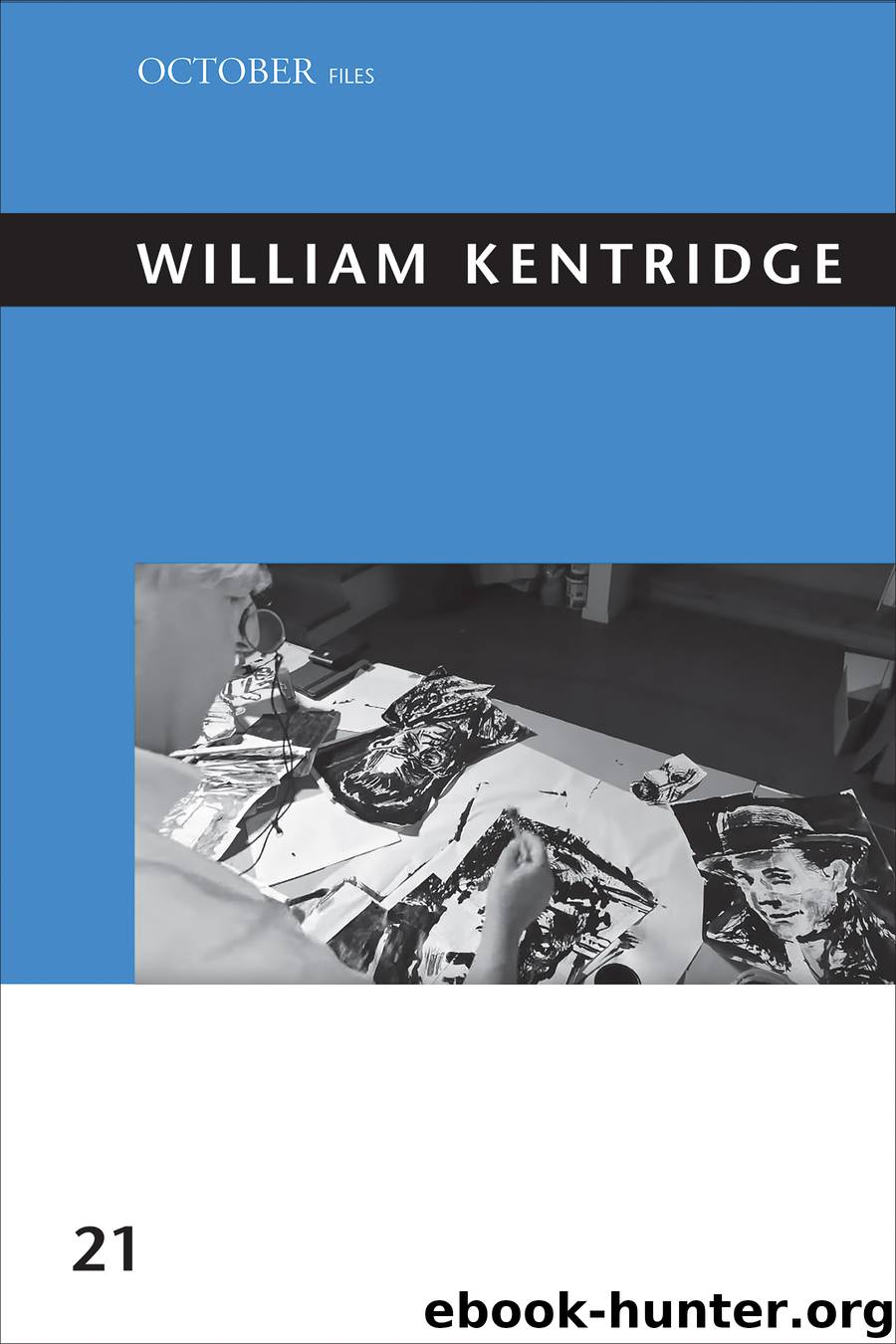William Kentridge by Krauss Rosalind E.;

Author:Krauss, Rosalind E.;
Language: eng
Format: epub
Publisher: MIT Press
Published: 2017-08-25T04:00:00+00:00
William Kentridge, drawing from Mine, 1991. Charcoal on paper, 47 1/4 × 59 inches.
William Kentridge, drawing from Felix in Exile, 1994. Charcoal, pastel on paper, 31 1/2 × 47 1/4 inches.
By comparison with Mine, Felix in Exile seems more conciliatory. Here, too, landscape as history is a main theme. A female, black land surveyor with her theodolite points to the time after apartheid, when the land is surveyed anew and thus repossessed by its original inhabitants. At the same time, the land is littered with slain bodies which are then metaphorically and literally “covered” by newspapers, melt into the landscape, and become invisible. Here Kentridge used documentary press photos from the Sharpeville massacre as basis for his drawings. In a surreal mirror scene, Felix, the artist-intellectual, stands eye to eye with this female land surveyor. She appears both as a motherly comforting figure and as a figure of erotic attraction to the exile. But she, too, is shot in the end, her body metamorphosing into a sinkhole in the landscape. The film ends with a naked Felix seen from behind and standing in that sinkhole, helpless and at a loss. Kentridge’s words about the Johannesburg landscape remind me of one of the first scenes in Claude Lanzmann’s Shoah, when Simon Srebnik, survivor of the mass killings at Chelmno, returns to the killing fields, now a peaceful space at the edge of the forest. Kentridge says:
I’m really interested in the terrain’s hiding of its own history, and the correspondence this has … with the way memory works. The difficulty we have in holding on to passions, impressions, ways of seeing things, the way that things that seem so indelibly imprinted on our memories still fade and become elusive, is mirrored in the way in which the terrain itself cannot hold on to the events played out upon it.14
Even landscape, a cipher of invariability and consistency, is not in a position to hold on to the past and to provide witness. Felix remembers the violence done, but he is the intellectual outsider who does not convert his memory into political agency, perhaps a reflection by the artist on his own situation. Kentridge speaks not of the futility or impossibility, but of the difficulty of holding on. Thus he does not embrace the dark melancholy that characterizes a writer like W. G. Sebald who, in his last novel Austerlitz, has the narrator, haunted by colonial and Nazi violence, reflect on memory:
Even now, when I remember …, the darkness does not lift but becomes yet heavier as I think how little we can hold in mind, how everything is constantly lapsing into oblivion with every extinguished life, how the world is, as it were, draining itself, in that the history of countless places and objects which themselves have no power of memory is never heard, never described or passed on.15
The Afterlife of Modernism and the Avant-Garde
In the 1960s, Adorno spoke of a fraying of the arts, an observation that already then questioned any emphatic modernist notion of THE medium.
Download
This site does not store any files on its server. We only index and link to content provided by other sites. Please contact the content providers to delete copyright contents if any and email us, we'll remove relevant links or contents immediately.
The Secret History by Donna Tartt(18225)
Red Sparrow by Jason Matthews(5204)
Harry Potter 02 & The Chamber Of Secrets (Illustrated) by J.K. Rowling(3559)
In a Sunburned Country by Bill Bryson(3376)
Drawing Cutting Edge Anatomy by Christopher Hart(3301)
Figure Drawing for Artists by Steve Huston(3277)
Harry Potter and the Prisoner of Azkaban (Book 3) by J. K. Rowling(3125)
The Daily Stoic by Holiday Ryan & Hanselman Stephen(3116)
Japanese Design by Patricia J. Graham(3006)
The Roots of Romanticism (Second Edition) by Berlin Isaiah Hardy Henry Gray John(2825)
Make Comics Like the Pros by Greg Pak(2763)
Stacked Decks by The Rotenberg Collection(2699)
Harry Potter and the Deathly Hallows (7) by J.K. Rowling(2554)
Draw-A-Saurus by James Silvani(2514)
Tattoo Art by Doralba Picerno(2497)
On Photography by Susan Sontag(2494)
Foreign Devils on the Silk Road: The Search for the Lost Treasures of Central Asia by Peter Hopkirk(2389)
Churchill by Paul Johnson(2374)
The Daily Stoic by Ryan Holiday & Stephen Hanselman(2353)
